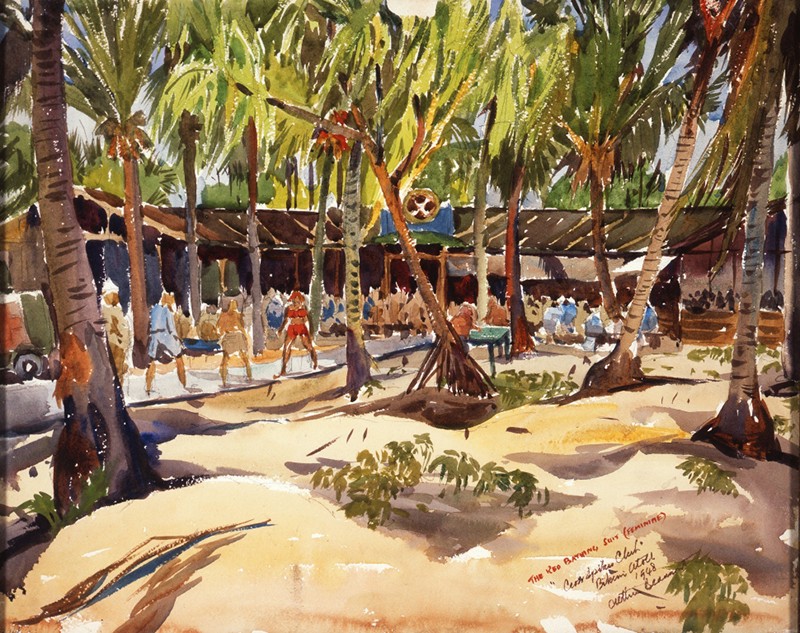 |
The Red Bathing Suit, 1948
Arthur Edwaine Beaumont (American, 1890-1978)
Watercolor on paper;
97.144
Gift of Dr. and Mrs. Robert Dreibelbis |
Arthur Edwin Crabbe was born on March 25, 1890 in Thorpe-St. Andrew, England. His father was a medical attendant in the British Military, and his mother was a nurse who encouraged her five children to draw and paint. After graduating with a degree from the Holt School, he moved with his friend to Canada to work on a ranch. It was there he sketched ranch-life and scenes on the prairie and realized he wanted to study art.
In 1909, after almost a year on a ranch, he decided to move to California to be with his brother Will and study at University of California School of Art in San Francisco. After a few odd jobs through the years, Arthur became a ranch hand in the San Joaquin Valley in 1912. Arthur was later involved in a cattle rustling conspiracy where the Perini brothers and family sought vengeance on him for notifying police of their involvement and subsequent jail time. After a terrible attack almost killed him, Arthur fled and changed his name to Arthur Edwaine Beaumont-Crabbe, which he later shortened to Arthur Edwaine Beaumont. By 1915, he was in Los Angeles and was struggling to make a living as a professional artist. In the 1920s, Beaumont received funding to study in Europe where he developed an impressionist style. Upon returning to California, he focused on portraits and maritime art.
In the 1930s, Beaumont caught the attention of the Navy with his acclaimed portraits. He was later commissioned as a Lieutenant in the U.S. Naval Reserve, where he worked on location over the years sketching and painting on naval tours and field trips. He was on the USS Indianapolis where President Roosevelt praised his work, he was commissioned by the National Geographic Magazine to do a series aboard navy ships, and by World War II, he was America's foremost military artist helping with a war bond campaign by selling signed lithographs.
After the war, Arthur continued sketching and painting naval activity around the world. He spent time in Antarctica where he painted through severe weather conditions. He enjoyed painting watercolors outdoors though, even in noisy shipyards or in life-threatening situations, just so he could produce plein air watercolors.
In 1946, Beaumont was selected as an official artist for "Operation Crossroads" on Bikini Atoll during the atomic bomb tests. With over 180 sketches and watercolor paintings, he recorded the events and the effects of the bombings. This painting, “The Red Bathing Suit,” shows a rare look at the people living on Bikini Atoll during the bomb tests. Beaumont depicts a scene where he noticed that a woman in a red bathing suit was the only nurse not wearing a standard issue gray suit, standing out from the crowd with her vibrant color. According to the artist’s son, Geoffrey, Arthur convinced her to roll up her suit because it looked frumpy, making her suit look like the beginnings of what became the “bikini.” After hearing about the atomic bombings on Bikini Atoll, the French designer Louis Réard named his new two-piece bathing suit a “bikini” due to the shocking nature of the first bathing suit to reveal the navel.
This painting was signed and dated much later in Beaumont’s life, so the word “feminine” next to the title on the artwork itself is to signify the subject as a female since most of the habitants on the island were male and no woman showed as much skin while wearing a bathing suit. The year is also mistakenly labeled as 1948, but that would have been during Beaumont's travels aboard naval ships in Japan and China.
After several injuries and close calls throughout his career, Beaumont continued to paint plein air watercolors even in old age. He returned to Antarctica in 1959 as the staff artist on the USS Glacier and made it to the South Pole suffering through more treacherous conditions. In the 1960s, he traveled to Vietnam to record the Navy's small craft operations against the Viet Cong. He was still doing commissioned work well into his eighties, painting naval ships five days a week at his home in Laguna Hills, until he passed away on January 23, 1978.
All images and text under copyright. Please ask Collection Department for permission to use. Information subject to change upon further research.


Comments